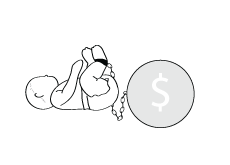Historical Inflation-Adjusted and Per Capita US Deficit Numbers, 1940-2010
 The Treasury Department announced on Tuesday that the federal deficit has already topped $1 trillion with three months left to go in the budget year.
The Treasury Department announced on Tuesday that the federal deficit has already topped $1 trillion with three months left to go in the budget year. This is down slightly from the same time last year (1.0 trillion vs 1.09 trillion), but itís still a mind-bogglingly high number. So high, in fact, that I think that many people have just become numb to the steadily increasing national public debt total. The debt load of the United States is so unspeakably high at this point that I think that most people are just starting to tune out and hope that the problem goes away by itself.
How did we get to this point? How does the current fiscal deficit compare with some of the past mega-deficits?
In order to truly compare apples with apples, we first need to do two things:
a) adjust for inflation
b) divide inflation-adjusted deficit totals by population to arrive at a per capita number
So, the first step is to take the information from 1940-2010 and adjust for inflation. After doing that, letís rank them starting with the largest inflation-adjusted deficits and work our way down (to the very rare surpluses)
Year | Deficit/Surplus | Rep/Dem President
2009 | -1.4 TRILLION | DEM
2010 | -1.35 TRILLION | DEM
1943 | -669.396 BILLION | DEM
1944 | -574.056 BILLION | DEM
1945 | -561.204 BILLION | DEM
2004 | -462.56 BILLION | REP
2008 | -455 BILLION | REP
1983 | -442.614 BILLION | REP
1992 | -438.504 BILLION | REP
2003 | -430.1 BILLION | REP
1986 | -429.128 BILLION | REP
1991 | -420.108 BILLION | REP
1985 | -418.231 BILLION | REP
1984 | -378.216 BILLION | REP
1993 | -374.997 BILLION | DEM
1990 | -358.344 BILLION | REP
2005 | -347.71 BILLION | REP
1994 | -290.576 BILLION | DEM
1982 | -281.6 BILLION | REP
1987 | -279.939 BILLION | REP
1988 | -277.808 BILLION | REP
1976 | -274.901 BILLION | REP
1942 | -266.705 BILLION | DEM
1989 | -260.775 BILLION | REP
2006 | -260.4 BILLION | REP
1995 | -227.96 BILLION | DEM
1975 | -209.608 BILLION | REP
1978 | -192.4 BILLION | DEM
1980 | -190.404 BILLION | DEM
1977 | -187.95 BILLION | DEM
2002 | -186.204 BILLION | REP
1981 | -184.07 BILLION | REP
1946 | -172.992 BILLION | DEM
2007 | -165.24 BILLION | REP
1968 | -153.72 BILLION | DEM
1996 | -145.125 BILLION | DEM
1971 | -120.52 BILLION | REP
1979 | -118.844 BILLION | DEM
1972 | -118.638 BILLION | REP
1959 | -93.312 BILLION | REP
1973 | -71.222 BILLION | REP
1941 | -70.707 BILLION | DEM
1967 | -54.61 BILLION | DEM
1953 | -51.675 BILLION | REP
1962 | -49.913 BILLION | DEM
1940 | -43.935 BILLION | DEM
1964 | -40.415 BILLION | DEM
1963 | -33.264 BILLION | DEM
1997 | -29.04 BILLION | DEM
1950 | -27.311 BILLION | DEM
1974 | -26.23 BILLION | REP
1966 | -24.235 BILLION | DEM
1955 | -23.76 BILLION | REP
1961 | -23.43 BILLION | DEM
1958 | -20.552 BILLION | REP
1970 | -15.316 BILLION | REP
1952 | -12.015 BILLION | DEM
1954 | -9.468 BILLION | REP
1965 | -9.436 BILLION | DEM
1960 | 2.148 BILLION | REP
1949 | 5.346 BILLION | DEM
1969 | 18.496 BILLION | REP
1957 | 25.67 BILLION | REP
1956 | 30.42 BILLION | REP
1947 | 38.08 BILLION | DEM
1951 | 49.776 BILLION | DEM
1998 | 89.96 BILLION | DEM
1948 | 103.958 BILLION | DEM
2001 | 152.76 BILLION | REP
1999 | 159.512 BILLION | DEM
2000 | 290.772 BILLION | DEM
As you can see, the number of surpluses are greatly outweighed by the number of deficits.
Again, these are inflation-adjusted numbers.
--
Now here are the per capita deficit numbers (inflation-adjusted):
1943 | $-4,897 | DEM
2009 | $-4,601 | DEM
2010 | $-4,397 | DEM
1944 | $-4,148 | DEM
1945 | $-4,011 | DEM
1942 | $-1,979 | DEM
1983 | $-1,893 | REP
1986 | $-1,787 | REP
1985 | $-1,758 | REP
1992 | $-1,720 | REP
1991 | $-1,666 | REP
2004 | $-1,607 | REP
1984 | $-1,604 | REP
2008 | $-1,524 | REP
2003 | $-1,509 | REP
1993 | $-1,455 | DEM
1990 | $-1,437 | REP
1976 | $-1,261 | REP
1946 | $-1,223 | DEM
1982 | $-1,216 | REP
2005 | $-1,198 | REP
1987 | $-1,155 | REP
1988 | $-1,136 | REP
1994 | $-1,117 | DEM
1989 | $-1,057 | REP
1975 | $-971 | REP
2006 | $-889 | REP
1995 | $-868 | DEM
1978 | $-865 | DEM
1977 | $-854 | DEM
1980 | $-838 | DEM
1981 | $-802 | REP
1968 | $-766 | DEM
2002 | $-660 | REP
1971 | $-581 | REP
1972 | $-565 | REP
2007 | $-559 | REP
1996 | $-547 | DEM
1941 | $-530 | DEM
1979 | $-528 | DEM
1959 | $-525 | REP
1973 | $-336 | REP
1940 | $-333 | DEM
1953 | $-323 | REP
1967 | $-275 | DEM
1962 | $-268 | DEM
1964 | $-211 | DEM
1950 | $-179 | DEM
1963 | $-176 | DEM
1955 | $-143 | REP
1961 | $-128 | DEM
1966 | $-123 | DEM
1974 | $-123 | REP
1958 | $-118 | REP
1997 | $-108 | DEM
1952 | $-76 | DEM
1970 | $-75 | REP
1954 | $-58 | REP
1965 | $-49 | DEM
1960 | $12 | REP
1949 | $36 | DEM
1969 | $91 | REP
1957 | $149 | REP
1956 | $180 | REP
1947 | $264 | DEM
1951 | $322 | DEM
1998 | $333 | DEM
2001 | $543 | REP
1999 | $585 | DEM
1948 | $709 | DEM
2000 | $1,033 | DEM
As you can see, 1943 topped the list, but not by much. 2009 and 2010 are currently #2 and #3 on the list respectively, and I donít see them getting bumped anytime soon.
Source: Davemanuel.com - A History of Surpluses and Deficits in the United States
Filed under: General Knowledge



